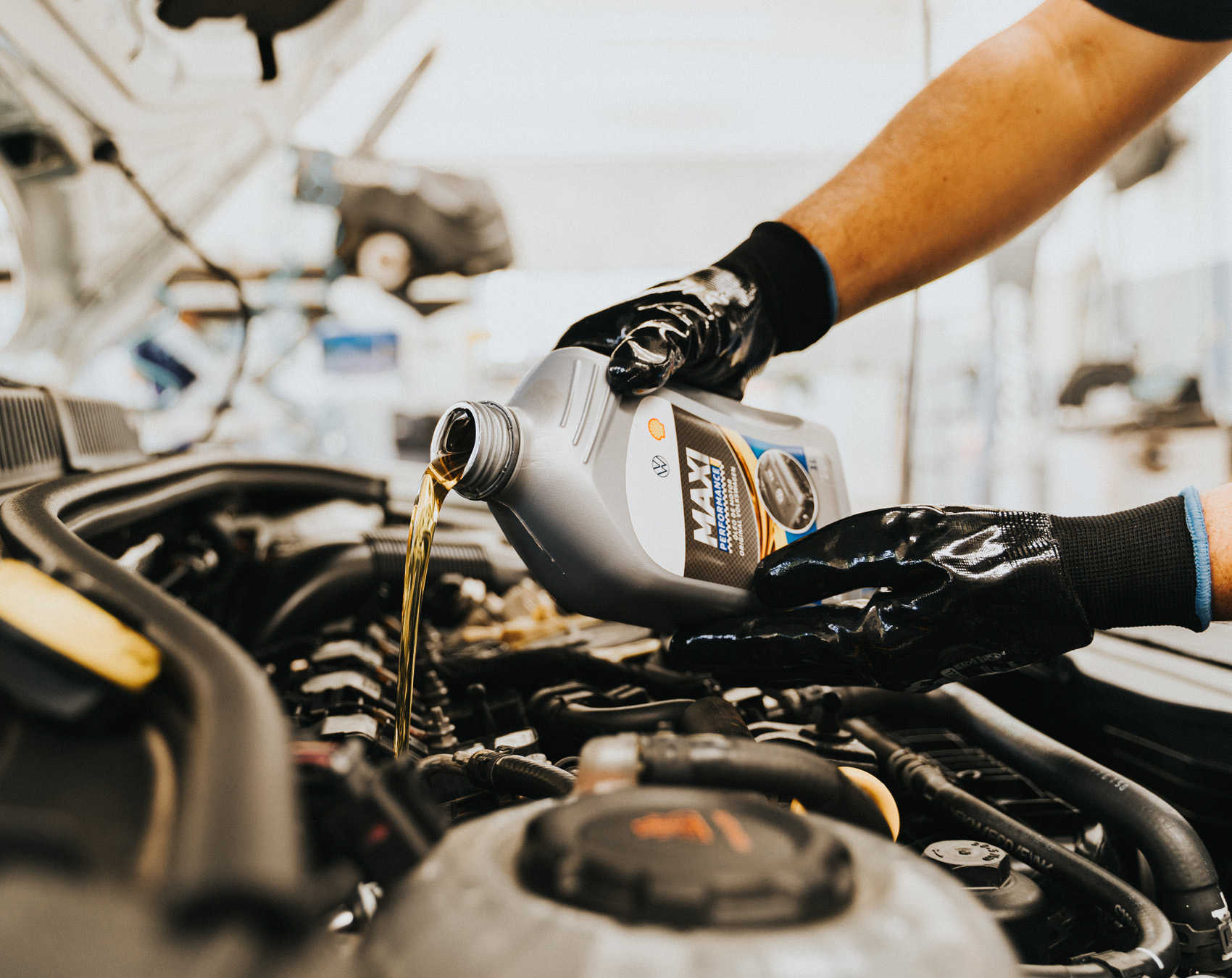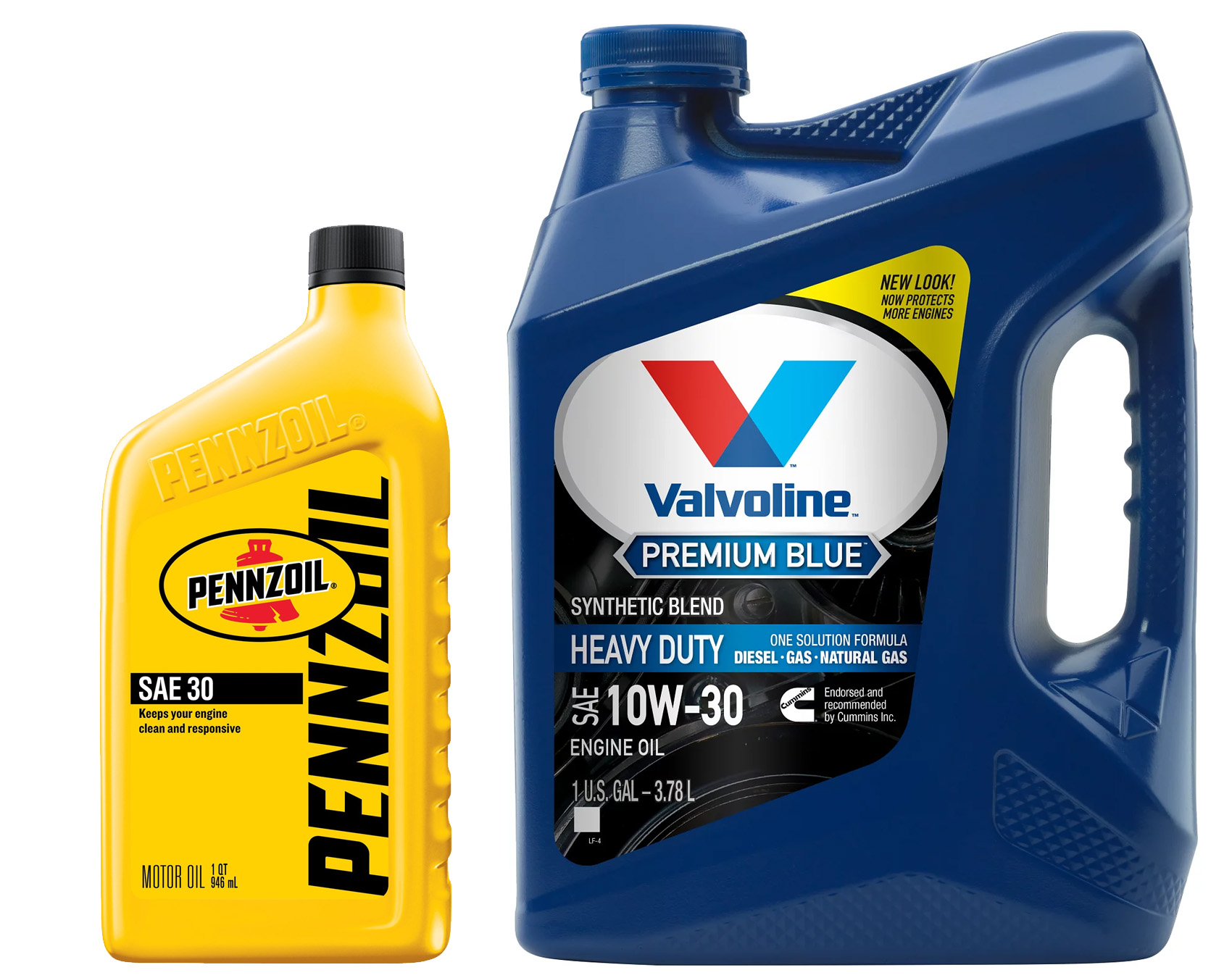SAE30 Vs 10W30 Oil
SAE30 is thicker oil than 10W30. The number “30” refers to the oil’s viscosity when the engine is hot. So both SAE30 and 10W30 have the same viscosity once the motor heats up. But, 10W30 is thinner when the oil is cold. 10w30 oil has a viscosity of 10w at low temperatures. This means it will flow easier and protect engine parts at a colder temperature than SAE30 will. SAE30 has a constant viscosity of 30 which provides less protection in the cold. When comparing SAE30 vs 10W30, you need to consider the application and temperature. In some cases, an oil that’s a consistent thickness can be better. But in colder climates, it’s usually best to use 10W30 vs SAE30 because it provides protection at engine startup.
Overall, SAE30 and 10W30 are both great motor oils for boats, cars, trucks, generators and lawn mowers. SAE30 is best for older cars and warmer climates, while 10W30 is better for varied temperatures or year-round use.
- SAE30 is a better oil for warm temperatures because it has a consistent viscosity of “30”. This is fine when temperatures are high, but too thick when it’s cold outside. It’s better for older engines with some wear because thicker oil helps retain pressure.
- 10W30 is a better oil when it’s cold because it has a variable viscosity. It’s a “10” when the temperature is cold but becomes a “30” when it heats up. This provides better protection for engine parts during cold starts in cold weather.
Oil is one of the most important substances used in a motor. It plays a crucial role in lubricating engine parts, reducing friction and preventing wear on engine components. But not all oil is created equal, different types are formulated for various purposes.
In this article, we’ll discuss the differences between SAE30 Vs 10W30 oil so you can make an informed decision when choosing which type to use in your engine.
Is SAE30 The Same As 10W30 Oil?
No, SAE30 and 10W30 are not the same type of oil. The biggest difference between these two oils is their viscosity. Viscosity is a measure of how the oil flows at high and low temperatures and is represented by a number. In this case “10” and “30”. The first number is the oil’s viscosity at low temperatures, the second number is the viscosity at high temperatures.
While both oils have a viscosity of “30” when the engine temperature is hot, 10W30 is thinner at low temperatures.
- SAE30 is thicker and has a consistent viscosity at low and high temperatures. This makes it better for older engines and in warm climates.. It won;t flow at the same rate as 10W30 but it always retains good pressure
- 10W30 is thinner oil at low temperatures vs SAE30 but it has the same viscosity once the engine heats up. This makes it better for cold climates and all around use.
If you’re comparing 10W30 to SAE30 for a car, truck, lawn mower, generator etc., consider the engine’s age and the climate. Both types of oil are really good but for different applications.
What Does SAE30 Mean?
SAE stands for the Society of Automotive Engineers. They created the classification system for oil based on its viscosity so its easier to compare different oil types. Motor oil typically has a viscosity rating between 0 and 50. When motor oil has one number, it means the viscosity is the same when temperatures are low and high. But when there are two numbers, such as with 10W30 oil, the first number is the oil’s viscosity at low temps, while the second number is its viscosity at high temps.
SAE30 means this oil has a constant viscosity of 30 based on the SAE system. That’s a high enough rating for most engines you’ll find in care, truck, boats, lawn mowers and generators.
However, a viscosity of 30 may be a little thick in cold temperatures. This is why oil like 10W30 was created. It provides the same protection at high temps, but is easier to crank when its cold outside.
What Does 10W30 Mean?
10W30 is thinner than SAE30 and flows easier in cold temperatures. This makes it a better all year oil in both hot and cold temperatures. The number “10” means its thin and flows easily at low temperatures. The “30” means it has the same viscosity as SAE30 oil when the engine is hot. An oil with variable viscosity is better in cold climates because thick oil is harder to crank when it gets cold outside.
However, thin oil isn’t as good for older engines with lots of wear because it doesn’t provide as much pressure at cold-start.
Pros & Cons Of SAE30 Vs 10W30 Oil
Both SAE30 and 10W30 are great motor oils weights. But they have their own pros, cons and best uses. When choosing between the two, you need to consider the age of the engine, its miles, wear and the average temperature.
| Pros | Cons | |
| 10W30 | Thinner oil with low viscosity in cold temperatures | Not as good as SAE30 in warmer weather |
| Doesn’t offer as much protection to older vehicles | ||
| Not as good for small engines | ||
| Slightly cheaper averaging $6 per quart/$22 per gallon for conventional blends | ||
| SAE30 | High viscosity helps protect older engines | A little too thicker for some engines |
| Not the best choice for new cars | A little more expensive averaging $7 per quart/$25 per gallon for conventional blends | |
| Great for small engines in lawn mowers & generators | Not the best in cold climates | |
| Works best in high temperatures |
Benefits Of SAE30 Oil
There are several benefits to using SAE30 oil vs 10W30 which includes a more consistent viscosity. It’s a thicker oil that works better in hot climates, in older cars and in small engines.
SAE30 Improves Engine Performance
One of the biggest benefits of using SAE30 oil is that it can help improve the performance of a small or older engine.
- The oil is specifically designed to reduce friction and wear on a small engine’s moving parts. This, in turn, can help reduce the amount of heat generated by the engine, which can help extend engine life.
- In older engines, SAE30 lubricates better and helps maintain steady oil pressure.
Although SAE30 is better than 10W30 in most small and older engines, it’s not as good in newer cars and trucks.
It Provides Better Lubrication
Another benefit of using SAE30 oil is that it provides better lubrication than other types of oil for some engines. This means that your machinery will run smoother and more efficiently. You’ll also find that your machinery is less likely to overheat or break down due to lack of lubrication.
SAE30 Can Help Save Money
Using SAE30 oil can also help you save money in the long run. Because the oil provides better lubrication and improves engine performance, your machinery won’t have to work as hard to function properly. This means that you’ll save money on fuel and other operating costs over time. However the oil itself is slightly more expensive per quart vs 10W30 oil.
It’s A Versatile Motor Oil
Another great benefit of SAE30 oil is that it can be used is a variety of engine types. It’s suitable for use in all sorts of engines, gearboxes, and other mechanical components. This versatility means that you can use one type of oil for all of your machinery instead of having to purchase multiple types of oil.
It’s Easy To Find
SAE30 oil is easy to find at most automotive stores and other retailers. This means you won’t have to spend a lot of time searching for the oil you need. There’s also no need to store lots of oil in the garage for future use. You can simply go to a nearby store and pick up a quart of SAE30 oil for your machinery any time you need it.
Benefits Of 10W30 Motor Oil
There are several benefits to using 10W30 motor oil vs SAE30 which includes better viscosity at low temperatures. It’s a thinner oil that works better in colder temperatures and modern engines. And it’s a little cheaper per quart.
Improved Fuel Economy:
One of the most significant benefits of using 10W30 motor oil is that it can improve fuel efficiency of your vehicle. This is because it has a lighter oil viscosity at startup. More viscosity at startup allows the oil to move more smoothly through the engine at cold temperatures vs thicker SAE30 oil. More viscosity means less friction and less fuel consumption by your engine.
Over time, this can lead to saving money considering how frequently many of us fill up our cars, trucks and other engines.
Reduced Emissions:
Using 10W30 oil vs SAE30 can also help reduce pollution and harmful emissions. The light viscosity of 10W30 oil allows it to flow quickly and easily through the engine. This leads to reduced engine wear and tear, less emissions from warn engine parts and less repairs.
When an engine functions better, it creates fewer harmful emissions. This leads to a decrease in pollution emitted by your car. By choosing 10W30 oil, you can lower the number of pollutants that your car releases into the environment.
However, always keep in mind the manufacturer’s recommended oil weight for your engine. 10W30 is a great motor oil, but it’s not the best choice for every engine.
Reduced Engine Wear & Tear:
10W30 oil is an excellent choice for both newer and older vehicles. Some synthetic blends have additives that help keep the engine clean and minimize wear and tear on engine parts. This can lead to a longer engine lifespan which can save money and cut down on emissions.
- 10W30 oil has excellent lubrication properties which protect the engine from high-stress conditions under heavy load.
- 10W30 motor oil is thinner than SAE30 when cold which reduces wear and tear at startup.
Using the appropriate oil weight can significantly reduce the amount of metal-to-metal contact that occurs within your engine. This can extend engine life while cutting down on emissions and the need for costly repairs.
Excellent Cold Weather Performance:
If you live in an area that experiences cold temperatures, 10W30 oil is a much better choice vs SAE30. Its low-temperature viscosity or just “10” allows it to start quickly in cold temperatures. This even includes when temperatures drop below freezing.
If you live in a colder climate, 10W30 oil can help improve your car’s overall performance and reduce wear and tear on the engine.
10W30 Is More Affordable Vs SAE30:
10W30 oil is a more cost-effective vs SAE30 oil for most car owners. It comes in several different forms which includes conventional oil, synthetic oil and blends. Within each type, there are cost effective options that work in just about any type of engine.
The Differences Between SAE30 VS 10W30 Motor Oil
SAE30 and 10W30 are both great motor oils with the same viscosity at high temperatures. However there are some difference that set the two apart. The biggest being that SAE30 is thicker and has a consistent viscosity while 10W30 is thinner and has a variable viscosity that changes with temperature. Because of their difference, neither oil is better at all situations than the other.
- SAE30 oil has a higher overall viscosity rating, meaning it’s thicker and better suited for use in warmer temperatures. It’s also great for older engines that benefit from thicker oil and more pressure.
- 10W30 oil has a lower overall viscosity rating and is designed for use in colder temperatures. It’s a bit cheaper than SAE30 oil.
When choosing between SAE30 and 10W30 motor oil, consider the engine’s wear and tear, temperature, application and the size of the motor. Certain engines may require a specific type of oil, so be sure to consult your owner’s manual before making a decision. Ultimately, choosing the right oil can help prolong the life of your engine and ensure optimal performance in any driving condition.
SAE30 Oil Qualities
SAE30 is a very common oil that’s used predominately in older motors and small engines. It’s thicker than 10W30 with a consistent viscosity of “30”. This makes it ideal for older engines that need steady pressure and warm climates that don;t benefit from thin oil at startup.
Below are some properties you should consider about SAE30 oil before using it.
Overall Performance
SAE30 is best when used in high temperatures. It’s thicker than 10W30 with an even consistency that doesn’t get thin when temperatures drop. This makes it great for older motors that need steady pressure. It’s also really good for smaller sized engines like lawn mowers and generators.
Detergents
Many oils contain detergents that are designed to trap dirt which helps keep the engine free of sludge. Some people don’t like detergents because in some cases they can actually harm the engine. Luckily SAE30 oil comes with or without detergents so you can choose which to use in your motor.
Oil Pressure
SAE30 oil is thicker which helps it withstand high amounts of pressure. It’s been tested for long periods of time in extreme temperatures up to 212℉. This makes it a good choice for engines that run at high rpm and generate high heat. Many small motors used in things like lawn mowers and generators fall into this category. Since they don’t have a transmission or gears which can reduce rpm, and they sometime runs for long periods of time, they tend to generate more heat than traditional car engines do.
High Viscosity
SAE30 has a viscosity rating of “30”, which means it flows well in warm or hot weather. It can deal with the high temperature created by an engine and the friction caused by moving parts.
High Operating Temperature
SAE30 has been rated for use in high temperatures. It reaches peak viscosity at around 212℉ but will break down once engine temperature reaches 250-260℉. This causes the engine to overheat.
Average Price Per Quart
On average, conventional SAE30 is slightly more expensive vs 10W30 at around $7 per quart or $25 per gallon. However synthetic formulas can cost twice as much. Because it’s most commonly used in smaller sized engines, you usually don’t need as much. However the manufacturer of the oil has a lot to do with the price. Because of how important motor oil is to the engine, I recommend buying a high quality oil vs a cheaper store brand.
10W30 Oil Qualities
10w30 is one of the most popular oil weights sold because it’s used in a variety of modern cars and trucks as well as other types of engines. Because it’s relatively thin at cold temperatures and has a viscosity of “30” when the engine heats up, it works well in both hot and cold environments. This makes it ideal as an all around motor oil.
Before using 10W30 oil, check the manufacturers recommendations for your engine. There may be a requirement you need to be aware of.
Here are a few factors to consider about 10W30 oil before using it.
Overall Performance
10W30 works great at both high and low temperatures because it has variable viscosity. It also a has low viscosity of “10” when it’s cold which is a good choice for people who live in a varied or cold climate. But it also has a viscosity of “30” when the engine heats up, which is enough to provide adequate protection for almost any size engine.
Because 10W30 oil is so popular, it’s mass produced. This brings the price down a bit making it a cheaper option vs SAE30 oil.
Composition
10W30 is sold in a few different forms which includes conventional motor oil as well as synthetic and blends.
- Conventional is primarily made from crude oil mixed with some additives.
- Synthetic oil tends typically outperforms conventional oil and better protects the engine over time. But it’s more expensive.
Always check with your engine manufacturer to see if they recommend conventional oil or a synthetic before you add oil to your engine. And make sure to always change and use the correct type of filter when changing the oil.
Oil Pressure
10W30 is thinner than SAE30 motor oil, which means it doesn’t create as much pressure. This is good for some engines but not as good for others. For example, many older engines with wear and tear perform better with thicker oil because it helps maintain pressure. But newer cars with modern engines tend to work better with a thinner oil.
Variable Viscosity
10W30 has variable levels of viscosity which change with temperature. When the engine is cool, 10W30 oil has a viscosity of 10. This flows very easy and makes cold engine starts easier. But when the engines heats up, the oil’s viscosity increases to 30, which is better at handling high heat. This is why 10W30 is a better all around motor oil vs SAE30.
Operating Temperature
10W30 oil works best in temperatures up to 212℉. But just like SAE30, it begins to break down at around 260℉ which causes the engine to overheat. However, because it’s thinner and has a viscosity of “10” in cold weather, it works well even in freezing temperatures.
Because 10W30 has a variable viscosity, it works well in both cold and hot climates. This is ideal for most people because even in hot areas of the country, temperatures can sometimes get quite cold at night.
Average Price per Quart
Conventional 10W30 is cheaper vs SAE30 motor oil at around $6 per quart or $22 per gallon. However synthetic formulas can cost twice as much. Because 10W30 is used more than SAE30 in modern full size motors rather than small engines, you typically end up using more per oil change.
The manufacturer plays a big role in determining the price of. And because of how important motor oil is to an engine, I recommend buying a high quality oil over a cheaper store brand.
When Should I Use SAE30 Oil?
You should use SEE30 oil if you live in a hot climate where cold isn’t a factor or have an older engine. SAE30 is thicker than 10W30 oil which helps maintain pressure and protects aging engine parts. SAE30 is also better for many small engines found in things like lawn mowers and generators.
Before choosing a motor oil, check with the manufacturer. Most engines have a recommended oil weight that works best.
When Should I Use 10W30 Oil?
You should use 10W30 oil in cold or changing climates and newer engines that work better with a thinner oil.
Before choosing a motor oil, check with the manufacturer. Most engines have a recommended oil weight that works best.
Should I Use SAE30 Or 10W30 Motor Oil?
You should use 10W30 if you live in a cold or changing climate because it’s thinner. This means it lubricates and moves better at low temperatures. But it also provides a viscosity of “30” which is on par with SAE30 motor oil.
However you should use SAE30 if you live in a hot climate where thin oil isn’t as beneficial. Or if you’ve got an older engine because thicker oil helps maintain better pressure. It’s also great at protecting those older and warn out engine parts. SAE30 also has an advantage when used in many small engines because it does better at high temperatures.
Before choosing a motor oil, check with the manufacturer. Most engines have a recommended oil weight that works best.
The Importance Of Motor Oil In Engines
Motor oil is a vital component in keeping your car running smoothly. It acts as a lubricant between the moving parts of the engine which reduces friction and prevents wear and tear. Without motor oil, these parts would quickly break down, leading to expensive repairs or even engine failure.
- Prevent wear and tear
- Provides lubrication to moving engine parts
- Reduces heat and friction
- Cleans the engine
- Improves fuel efficiency
- Reduces emissions
Motor oil also helps to keep the engine at low temperatures by carrying heat away from the combustion chamber which prevents overheating. It also cleans the engine by removing debris and deposits that can accumulate over time.
It’s important to choose the right type of motor oil for your car. It can affect an engines performance, prevent wear and tear and increase fuel efficiency. So, the next time you take your car for an oil change, remember the critical role that motor oil plays in keeping your car in tip-top shape.
What Is Single Grade Oil
SAE 30 oil is considered a single grade oil. Single grade oil refers to oil that has a fixed viscosity rating. This means it stays the same viscosity or thickness across a range of temperatures. This type of oil is typically used in older motors and small engines. But it lacks the ability to flow as easily in colder temperatures.
- SAE30 oil is used by many vintage car enthusiasts because it tends to provide better protection against engine wear and tear.
- Single grade oil can be advantageous in high-temperature environments, as it tends to perform better than multi-grade oils.
- SAE30 is better than 10W30 in many smaller engines found in lawn mowers and generators.
Overall, single grade oil is a reliable, no-frills option for those who want a straightforward lubricant for their engine. But it’s not the best choice for many modern engines or engines that operate in cold environments.
What Is Multi Grade Oil
10W30 oil is considered a multi-grade oil. Multi-grade motor oil, unlike single-grade oils, provide protection in a wider temperature range. For example, 10W30 has a “10” viscosity rating in cold temperatures, but a “30” viscosity once the engine heats up. This provides lubrication at both low and high temperatures.
- 10W30 is considered a multi-grade motor oil.
- Multi-grade oils are designed to work in a wider temperature range.
- Most modern engines use multi-grade oil.
Multi-grade oils like 10W30 offer improved fuel economy and better engine performance then single grade oils like SAE30. This is especially true in colder environments where thinner oil helps most.
With different viscosity ratings available, choosing the right multi-grade oil can be a challenge, but the benefits are well worth the effort.
What Type Of Motor Oil Is Used For Lawn Mowers?
Most new lawnmower manufacturers recommend using a 10W30 oil for optimal performance. This type of oil provides better viscosity, making it easier for the engine to start and reducing the risk of excess wear and tear. However, older mowers may benefit by using thicker SAE30 oil. It’s thicker than 10W30 and helps lubricate warn engine parts.
Depending on the average temperature where you live, you want to consider using a thicker or thinner oil. 10W30 is thinner, and works much better when it’s cold outside. But SAE30 is thicker and typically outperforms 10W30 in high temperatures.
Taking care of your lawnmower is essential for keeping your lawn in tiptop shape during the warmer months. One of the most important aspects of maintenance is selecting the right type of motor oil for your mower. There are a variety of options to choose from, but it’s crucial to select the right oil that will keep your lawnmower running smoothly.
By using the right motor oil for your lawnmower, you can ensure that it will last long and work at its best capacity.
Is SAE30 Or 10W30 Thicker Oil?
SAE30 is a thicker motor oil than 10W30. SAE30 has a steady viscosity that works better in hot temperatures, while 10W30 is thinner and works better when temperatures get cold.
Can I Use 10W30 Instead Of SAE30 In My Lawnmower?
Yes, both SAE30 and 10W30 are suitable for most lawnmowers. However you should check with the manufacturer first to make sure. Some engines may have a preference. If your mower is older, the SAE30 will offer more protection because its thicker and maintains higher pressure.
Temperature makes a big difference with a small engine. Some small lawnmower engines may have a hard time with a thicker oil at startup. 10W30 has the same “30” viscosity as SAE30 when the engine heats up, but it’s thinner with just a “10” viscosity when it’s cold. This can help a small engine startup on cold days.
Can You Mix SAE30 & 10W30 Oil?
Yes, you can mix together SAE30 and 10W30 motor oils. Any SAE graded motor oil can be mixed with any other SAE graded motor oil. However the oils should be the same type. Do not mix conventional SAE oil with a synthetic or a blend. But it’s OK to mix an oil with detergents with a non-detergent oil.
Final Thoughts About SAE 30 Vs 10w30 Oil
In conclusion, SAE30 and 10W30 oil both serve an important purpose in keeping your motor running smoothly. While SAE30 is thicker and better suited for use in hot weather, 10W30 has a lower viscosity rating designed for colder climates. Ultimately, the right type of motor oil can help prolong engine life while ensuring optimal performance no matter what conditions you face on the road.
Be sure to consult your owner’s manual before making any decisions about which type of oil is best for your vehicle – it could make all the difference.
Summary: SAE30 Vs 10W30 Oil
SAE30 is thicker oil than 10W30. The number “30” refers to the oil’s viscosity when the engine is hot. So both SAE30 and 10W30 have the same viscosity once the motor heats up. But, 10W30 is thinner when the oil is cold. 10w30 oil has a viscosity of 10w at low temperatures. This means it will flow easier and protect engine parts at a colder temperature than SAE30 will. SAE30 has a constant viscosity of 30 which provides less protection in the cold. When comparing SAE30 vs 10W30, you need to consider the application and temperature. In some cases, an oil that’s a consistent thickness can be better. But in colder climates, it’s usually best to use 10W30 vs SAE30 because it provides protection at engine startup.
Overall, SAE30 and 10W30 are both great motor oils for boats, cars, trucks, generators and lawn mowers. SAE30 is best for older cars and warmer climates, while 10W30 is better for varied temperatures or year-round use.
- SAE30 is a better oil for warm temperatures because it has a consistent viscosity of “30”. This is fine when temperatures are high, but too thick when it’s cold outside. It’s better for older engines with some wear because thicker oil helps retain pressure.
- 10W30 is a better oil when it’s cold because it has a variable viscosity. It’s a “10” when the temperature is cold but becomes a “30” when it heats up. This provides better protection for engine parts during cold starts in cold weather.
Oil is one of the most important substances used in a motor. It plays a crucial role in lubricating engine parts, reducing friction and preventing wear on engine components. But not all oil is created equal, different types are formulated for various purposes.
If you have any questions or comments about SAE30 vs 10W30 oil, email any time.
























